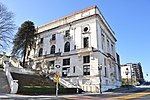The Old City Hall is a five-story building in Tacoma, Washington that served as the city hall in the early 20th century. The building features a ten-story clocktower on the southeast corner, facing the intersection of Pacific Avenue and S 7th Street.The building uses masonry bearing walls combined with numerous windows. The windows on the second and third floors are of equal size. The fourth story windows are arched at the top. The fifth story windows are smaller and narrower.The foundation is a local Wilkeson stone, which is light gray. The walls are eight feet thick at the base and taper to six feet at street level. They are covered with a façade of red brick faced with yellow Roman brick. These bricks are believed to have been ballast from China or Belgium or to have been imported from Italy. The tower is a freestanding masonry with a clock on each face.The building is a trapezoid in plan and reflects the Italian Villa style. Small round windows appear below the corner line; three large round windows occur below the corner on the tower.The tower's base has heavy brackets above the corner of the main structure and narrow rectangular windows on the tower body. A group of three arched windows are at the top on each side. A row of small round windows circles the tower between the arched windows and the eave line. Terra cotta decorations embellish the tower and areas of the entablature. The tower has a clock and a set of four bells. The clock and the bells were cast by the McShane Bell Foundry in Baltimore, the same company that cast the Liberty Bell. The bells is 8,000 pounds (3,600 kg) of silver bell metal. Hugh Campbell Wallace of Tacoma, who would later become the United States ambassador to France, gave the bells and chimes in memory of his daughter on Christmas Day, 1904. The pendulum of the clock, 12 feet (3.7 m) in length, is suspended on a single wire, 40 feet (12 m) in length. The mechanism is gravity run and the motors are wound electrically.









